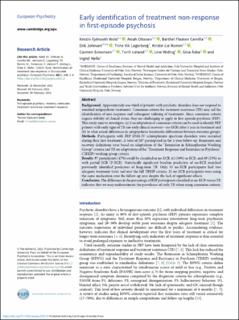| dc.contributor.author | Wold, Kristin Fjelnseth | |
| dc.contributor.author | Ottesen, Akiah | |
| dc.contributor.author | Flaaten, Camilla Bärthel | |
| dc.contributor.author | Johnsen, Erik | |
| dc.contributor.author | Lagerberg, Trine Vik | |
| dc.contributor.author | Romm, Kristin Lie | |
| dc.contributor.author | Simonsen, Carmen | |
| dc.contributor.author | Ueland, Torill | |
| dc.contributor.author | Widing, Line Hustad | |
| dc.contributor.author | Åsbø, Gina | |
| dc.contributor.author | Melle, Ingrid | |
| dc.date.accessioned | 2023-08-16T12:18:33Z | |
| dc.date.available | 2023-08-16T12:18:33Z | |
| dc.date.created | 2023-03-29T21:10:35Z | |
| dc.date.issued | 2023 | |
| dc.identifier.issn | 0924-9338 | |
| dc.identifier.uri | https://hdl.handle.net/11250/3084401 | |
| dc.description.abstract | Background
Approximately one-third of patients with psychotic disorders does not respond to standard antipsychotic treatments. Consensus criteria for treatment resistance (TR) may aid the identification of non-response and subsequent tailoring of treatments. Since consensus criteria require stability of clinical status, they are challenging to apply in first-episode psychosis (FEP). This study aims to investigate (a) if an adaptation of consensus criteria can be used to identify FEP patients with early signs of TR (no early clinical recovery—no-ECR) after 1 year in treatment and (b) to what extent differences in antipsychotic treatments differentiate between outcome groups.
Methods
Participants with FEP DSM-IV schizophrenia spectrum disorders were recruited during their first treatment. A total of 207 participated in the 1-year follow-up. Remission and recovery definitions were based on adaptations of the “Remission in Schizophrenia Working Group” criteria and TR on adaptations of the “Treatment Response and Resistance in Psychosis” (TRRIP) working group criteria.
Results
97 participants (47%) could be classified as no-ECR, 61 (30%) as ECR, and 49 (23%) as with partial ECR (P-ECR). Statistically significant baseline predictors of no-ECR matched previously identified predictors of long-term TR. Only 35 no-ECR participants had two adequate treatment trials and met the full TRRIP criteria. 21 no-ECR participants were using the same medication over the follow-up year despite the lack of significant effects.
Conclusion
The difference in the percentage of FEP participants classified as no-ECR versus TR indicates that we may underestimate the prevalence of early TR when using consensus criteria. | en_US |
| dc.language.iso | eng | en_US |
| dc.publisher | Cambridge University Press | en_US |
| dc.rights | Navngivelse 4.0 Internasjonal | * |
| dc.rights.uri | http://creativecommons.org/licenses/by/4.0/deed.no | * |
| dc.title | Early identification of treatment non-response in first-episode psychosis | en_US |
| dc.type | Journal article | en_US |
| dc.type | Peer reviewed | en_US |
| dc.description.version | publishedVersion | en_US |
| dc.rights.holder | Copyright 2023 The Author(s) | en_US |
| dc.source.articlenumber | e30 | en_US |
| cristin.ispublished | true | |
| cristin.fulltext | original | |
| cristin.qualitycode | 2 | |
| dc.identifier.doi | 10.1192/j.eurpsy.2023.15 | |
| dc.identifier.cristin | 2138296 | |
| dc.source.journal | European psychiatry | en_US |
| dc.identifier.citation | European psychiatry. 2023, 66 (1), e30. | en_US |
| dc.source.volume | 66 | en_US |
| dc.source.issue | 1 | en_US |

